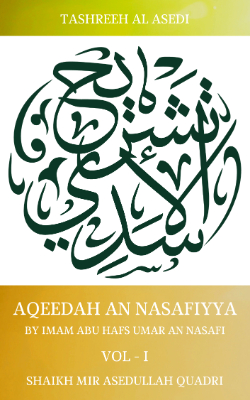
Tashreeh Al Asedi
Download and read all volumes of Aqeedah An Nasafiyya by Imam An Nasafi with English Translation and Explanation





IMAM ABU HAFS UMAR AN NASAFI ( أبو حفص عمرالنسفي رحمة الله عليه )
Imam Abu Ḥafṣ Umar bin Muḥammad An-Nasafī (1067-1142) (أبو حفص عمر بن محمد النسفي) was a Persian scholar, jurist, theologian, mufassir, muhaddith and historian.
BLESSED BIRTH
He was born in 437 AH (1067 CE) in a place called Nasaf in Maa Wara’an Nahr area, south-east of Bukhara, present Uzbekistan. He is known as ‘An-Nasafi’ because he was born in Nasaf. Information about his early life and ancestors is sketchy.
TEACHERS
Shaikh An-Nasafi sought knowledge from beyond Ma wara an Nahr and travelled to Iraq, Hijaz, and many other places. It is reported that in Makka he met Shaikh Zamakhshari a famous scholar in Arabic grammar. It is reported that he compiled a list of many Ulema he met and learned during his travels. A few of his famous teachers include, (i) Abu Al-Hasan Ali ibn Muhammad al-Bazdawi, the author of Usul al-Bazdawi, (ii) Abu al-Yusr al-Bazdawi, (iii) Abu al-Mu'in al-Nasafi, (iv) Abu Muhammad al-Hasan ibn Ahmad as-Samarqandi, (v) Abu-l Qasim ibn Bayan, (vi) Isma`il ibn Muhammad an-Noohi An-Nasafi, (vii) Abdullaah ibn Ali ibn Isa, etc.
STUDENTS
It is reported that Shaikh An-Nasafi had thousands of students who came to seek knowledge from him. Some of his students include (i) Burhaan-ud-Deen Al-Marghinaani, the author of famous Hanafi Fiqh book Al-Hidaya, (ii) Muhammad ibn Ibrahim at-Turubushti, (iii) Abul Laith Ahmad ibn Umar ibn Muhammad An-Nasafi, (iv) Abu Sa`d Abdul Kareem As-Sam`ani, etc.
BOOKS
Shaikh An-Nasafi is reported to have authored over 100 books, mostly in Arabic. The names of a few of his books are given blow.
- Al-Aqa’id An-Nasafia (العقائد النسفية), his most famous book on Aqeedah Ahle Sunnah.
- Al-Taysir fi al-Tafsir (التيسير في التفسير) his famous work in tafsir which is cited in many tafaseer written during Ottoman period.
- Tafsir-e Nasafi (تفسیر نسفی), a Persian translation of the Quran in rhymed prose. It is considered to be the third oldest translation of the Quran in the Persian language, and the only translation of Quran in rhymed prose.
- Manzumah fi al-Khilafyat (منظومة في الخلافيات), a book in the form of poetry, consisting of 2669 verses, explaining the differences in the views of Imam Abu Hanifa (ru) and his students, namely Abu Yusuf, Muhammad al-Shaybani and Zufur (رحمتہ اللہ علیہم) on legal rules, as well as the differences between Abu Hanifa and Al-Shafii and Malik ibn Anas (رضئ اللہ تعالی عنہم).
- Hasr al-Masa'il wa Qasr al-Dala'il (حصر المسائل وقصر الدلائل) is a commentary on Manzumah fi al-Khilafyat with a detailed exposition of the reasons for each legal rule.
- Tilbah al-Talabah fi al-Istilahat al-Fiqhiyya (طلبة الطلبة في الإصطلاحات الفقهية), a textbook used over centuries in Hanafi schools.
- Sharh Madar al-Usul (شرحُ مَدارِ الأصول), a commentary on Al-Karkhi's seminal work in Usul al-Fiqh.
- Al-Qand fi Zikr Ulama'e Samarqand (القند في ذکر علماء سمرقند), a biographical encyclopedia of Transoxiana's (central Asia’s) Islamic scholars.
DEATH OF IMAM NASAFI (رحمتہ اللہ علیه)
Imam An-Nasafi died in Samarqand on the 12 Jumada I, 537 A.H. (December 2, 1142 CE) and was buried there.
It is reported that, after his death, someone saw him in a dream and asked what happened. He said, the angels Munkar and Nakeer questioned me in the grave, and I told them should I answer in prose or poetry. They said, answer in poetry. So, I said - ربى الله لا اله سواه ونبيى محمد مصطفاه - دينى الاسلام وفعلى ذميم اسأل الله عفوه وعطاه [My Rabb is Allah and there is no God besides Him. My Prophet is Muhammad Mustafa (صلى الله عليه و آله وسلم), the chosen one, my Deen is Islam, and my deeds are blameworthy and I ask Allah for His Pardon and bounties].
SCHOLARS OPINIONS
Ad-Dhahabi (1274-1348) wrote in his famous book Siyar Alam An-Nubula - An-Nasafi was from the people of Samarqand and authored the tarikh of Samarqand, ‘Al-Mulaqqab bil Qand’. He composed al-Jami As-Saghir into poetry. He was an expert in many subjects and authored over a hundred books on Hadith, Tafsir, Islamic Sharia, etc. He narrated from Ismail bin Muhammed al-Nuhi, Al-Hasan bin Abdil Malik al-Qadi, Mehdi bin Muhammed al-Alawi, Abdullah bin Ali bin Isa an-Nasafi, Abi al-Yusr Muhammed bin Muhammed al-Nasafi, Husain al-Kashghari, Abi Muhammed al-Hasan bin Ahmed as-Samarqandi, and Ali bin al-Hasan Al-Maturidi.
As-Sam’ani (1113 – 1166) said, he was an Imam, a Faqih, an Aalim and Aarif who wrote 10 books in Fiqh and Hadith.
Ibn Najjar (1183 – 1246) said, he was a virtuous Faqih, Mufassir, Muhaddith, Adeeb, and Mufti.
It is reported that Imam An-Nasafi was given the title of ‘Najm-ud-Deen’, meaning, ‘the Star of the Deen’ and was referred as Shaikh-ul-Islam.
Shaikh Al-Marghinani (1135-1197), the author of famous Hanif Fiqh book Al-Hidaya said, he heard Najmuddin say, I narrate Ahadith from 550 Shuyookh.
© 2025 Sahih Iman | Terms | Privacy Policy | About Us | Contact